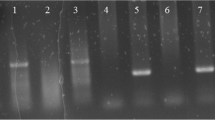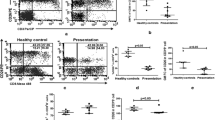Abstract
The crucial functions of chemokine/receptors in numerous parasitic infections, including leishmaniasis, are well documented. This study aimed to assess the serum levels of CC ligand (CCL) 2, CCL5, and CCL11 in cutaneous leishmaniasis (CL) patients. 64 patients, suffering from CL and 100 healthy people were selected, and their blood serum concentrations of CCL2, CCL5, and CCL11 were measured using enzyme-linked immunosorbent assay. The results demonstrated that while the mean serum levels of CCL5 and CCL11 increased significantly in CL patients, the mean serum levels of CCL2 decreased, compared to the control group. Despite the sufficient production of CCL5 and CCL11 in CL patients, they suffered from CCL2 deficiency, as the defense mechanism against parasitic infection. These findings suggest a mechanism that might partially explain the patients’ susceptibility to persistent infection and their inability to clear the parasites.

Similar content being viewed by others
Abbreviations
- CCL:
-
Chemokine (C–C motif) ligand
- CL:
-
Cutaneous leishmaniasis
- CR3:
-
Complement receptor 3
- CXCL:
-
Chemokine (C-X-C motif) ligand
- DCL:
-
Diffuse cutaneous leishmaniasis
- DL:
-
Disseminated leishmaniasis
- ELISA:
-
Enzyme-linked immune-sorbent assay
- ERK:
-
Extracellular signal-regulated kinase
- FcRs:
-
Fc receptors
- MR:
-
Mannose receptor
- IFN:
-
Interferon
- IL-12:
-
Interleukin-12
- MAPK:
-
Mitogen-activated protein kinase
- PBMC:
-
Peripheral blood mononuclear cell
- SPSS:
-
Statistical package for the social sciences
- Th1:
-
T helper 1
- TNF:
-
Tumor necrosis factor
- TLRs:
-
Toll-like receptors
References
Ahmadi Z, Arababadi MK, Hassanshahi G (2013) CXCL10 activities, biological structure, and source along with its significant role played in pathophysiology of type I diabetes mellitus. Inflammation 36:364–371
Aminzadeh F et al (2012) Differential expression of CXC chemokines CXCL10 and CXCL12 in term and pre-term neonates and their mothers. Am J Reprod Immunol 68:338–344
Arababadi MK, Pourfathollah AA, Jafarzadeh A, Hassanshahi G, Daneshmandi S, Shamsizadeh A, Kennedy D (2011) Non-association of IL-12 + 1188 and IFN-γ + 874 polymorphisms with cytokines serum level in occult HBV infected patients. Saudi J Gastroenterol 17:30
Banerjee A, Bhattacharya P, Joshi AB, Ismail N, Dey R, Nakhasi HL (2016) Role of pro-inflammatory cytokine IL-17 in Leishmania pathogenesis and in protective immunity by Leishmania vaccines. Cell Immunol 309:37–41
Boutsini S, Athanasiou LV, Spanakos G, Ntousi D, Dotsika E, Bisia M, Papadopoulos E (2018) Phlebotomine sandflies and factors associated with their abundance in the leishmaniasis endemic area of Attiki, Greece. Parasitol Res 117:107–113
Dassoni F, Daba F, Naafs B, Morrone A (2017) Leishmaniasis recidivans in Ethiopia: cutaneous and mucocutaneous features. J Infect Dev Countries 11:106–110
David BA, Kubes P (2019) Exploring the complex role of chemokines and chemoattractants in vivo on leukocyte dynamics. Immunol Rev 289:9–30
Desjeux P (2004) Leishmaniasis: current situation and new perspectives. Comp Immunol Microbiol Infect Dis 27:305–318
Gschwandtner M, Derler R, Midwood KS (2019) More than just attractive: how CCL2 influences myeloid cell behavior beyond chemotaxis. Front Immunol 10:2759
Guerin PJ et al (2002) Visceral leishmaniasis: current status of control, diagnosis, and treatment, and a proposed research and development agenda. Lancet Infect Dis 2:494–501
Gupta G et al (2019) Inflammasome gene expression is associated with immunopathology in human localized cutaneous leishmaniasis. Cell Immunol 341:103920
Hassanshahi G, Jafarzadeh A, Ghorashi Z, Sheikholeslami NZ, Dickson AJ (2007a) Expression of IP-10 chemokine is regulated by pro-inflammatory cytokines in cultured hepatocytes. Iran J Allergy Asthma Immunol 6:115–122
Hassanshahi G, Patel SS, Jafarzadeh AA, Dickson AJ (2007b) Expression of CXC chemokine IP-10/Mob-1 by primary hepatocytes following heat shock. Saudi Med J 28:514–518
Hughes CE, Nibbs RJ (2018) A guide to chemokines and their receptors. FEBS J 285:2944–2971
Kedzierski L, Evans KJ (2018) The role of the immune system in resistance to infection. In: Ponte-Sucre A, Padrón-Nieves M (eds) Drug resistance in leishmania parasites. Springer, Berlin, pp 109–142
Keselowsky BG, Acharya A, Lewis JS (2020) Innate and adaptive immunity: the immune response to foreign materials. In: Biomaterials science. Elsevier, pp 747–776. e741
Mathur RK, Awasthi A, Wadhone P, Ramanamurthy B, Saha B (2004) Reciprocal CD40 signals through p38MAPK and ERK-1/2 induce counteracting immune responses. Nat Med 10:540
Navas A, Vargas DA, Freudzon M, McMahon-Pratt D, Saravia NG, Gómez MA (2014) Chronicity of dermal leishmaniasis caused by Leishmania panamensis is associated with parasite-mediated induction of chemokine gene expression. Infect Immun 82:2872–2880
Nieto-Meneses R et al (2018) In vitro activity of new N-benzyl-1H-benzimidazol-2-amine derivatives against cutaneous, mucocutaneous and visceral Leishmania species. Exp Parasitol 184:82–89
Oghumu S, Lezama-Dávila CM, Isaac-Márquez AP, Satoskar AR (2010) Role of chemokines in regulation of immunity against leishmaniasis. Exp Parasitol 126:389–396
Polando R et al (2013) The roles of complement receptor 3 and Fcγ receptors during Leishmania phagosome maturation. J Leukoc Biol 93:921–932
Rabhi S et al (2016) Lipid droplet formation, their localization and dynamics during Leishmania major macrophage infection. PLoS One 11:e0148640
Radman M et al (2013) Serum levels of the CC chemokines CCL2, CCL5, and CCL11 in food allergic children with different clinical manifestations. Inflammation 36:561–566
Ridiandries A, Tan J, Bursill CA (2018) The role of chemokines in wound healing. Int J Mol Sci 19:3217
Ritter U, Körner H (2002) Divergent expression of inflammatory dermal chemokines in cutaneous leishmaniasis. Parasite Immunol 24:295–301
Salomon I, Netzer N, Wildbaum G, Schif-Zuck S, Maor G, Karin N (2002) Targeting the function of IFN-γ-inducible protein 10 suppresses ongoing adjuvant arthritis. J Immunol 169:2685–2693
Schaerli P, Willimann K, Lang AB, Lipp M, Loetscher P, Moser B (2000) CXC chemokine receptor 5 expression defines follicular homing T cells with B cell helper function. J Exp Med 192:1553–1562
Sofizadeh A, Hanafi-Bojd A, Shoraka H (2018) Modeling spatial distribution of Rhombomys opimus as the main reservoir host of zoonotic cutaneous leishmaniasis in northeastern Iran. J Vector Borne Dis 55:297
Teixeira MJ, Teixeira CR, Andrade BB, Barral-Netto M, Barral A (2006) Chemokines in host–parasite interactions in leishmaniasis. Trends Parasitol 22:32–40
Vinader V, Afarinkia K (2012) A beginner’s guide to chemokines. Future Med Chem 4:845–852
Wildbaum G, Netzer N, Karin N (2002) Tr1 cell–dependent active tolerance blunts the pathogenic effects of determinant spreading. J Clin Invest 110:701–710
Acknowledgements
The authors would like to take this opportunity to thank all the participants who attended and cooperated in this research study.
Author information
Authors and Affiliations
Corresponding authors
Ethics declarations
Conflict of interest
The authors declare that there is no conflict of interest.
Ethical standards
This article is prepared and presented by the author in accordance with the ethical standards.
Additional information
Publisher's Note
Springer Nature remains neutral with regard to jurisdictional claims in published maps and institutional affiliations.
Rights and permissions
About this article
Cite this article
Hassanshahi, G., Alavi, S.E., Khorramdelazad, H. et al. Serum levels of CC chemokine ligands in cutaneous leishmaniasis patients. J Parasit Dis 45, 153–158 (2021). https://doi.org/10.1007/s12639-020-01290-w
Received:
Accepted:
Published:
Issue Date:
DOI: https://doi.org/10.1007/s12639-020-01290-w




